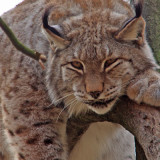CLASSIFICATION
Class: Mammalia
Order: Diprotodontia
Family: Phascolarctidae
Genus: Phascolarctos
Species: cinereus adustus
RANGE
Found from eastern Australia to southeastern Australia. Koalas have also been introduced to islands around the coast of eastern Australia including Phillip Island and Magnetic Island.
HABITAT
Habitats vary from temperate to tropical eucalyptus forests where the koala will move between around a dozen eucalyptus trees. They tend to live in core areas with lush eucalyptus.
SIZE
Koalas from northern parts of Australia tend to be smaller than their southern counterparts.
Adult male koalas are noticeably larger than adult female koalas, with a broader face and larger black nose.
Southern Koalas:
Male weight: 20 – 33 lbs.
Male length: 29 – 32 in.
Female weight: 15 – 24 lbs.
Female length: 26 – 29 in.
Northern Koalas:
Male weight: 9 – 20 lbs.
Male length: 26 – 29 in.
Female weight: 9 – 16 lbs.
Female length: 25 – 28 in.
REPRODUCTION
Koalas are marsupials; this means that, like other marsupial species, they give birth prematurely and nurture their newborn through their “pouch”. Koalas, like wombats, are different from other marsupials because their pouch faces backwards. During their breeding season (October to May), and after a gestation period of around 30 to 35 days, a female koala will give birth to a single joey. While in the pouch, they joey will nurse solely on the milk of its mother until around 6 months of age where the mother produces a substance called “pap.” Pap is important because it contains bacteria that allows the koala to digest eucalyptus leaves, which are crucial to their diets as adults. At around seven months, a joey can exit the pouch and start consuming leaves, but they often return to the pouch to continue nursing for up to one year. Sexual maturity is reached at 3 years old for females and around 4 years old for males. Koalas may produce a joey each year if conditions permit. However, many populations of koalas have been affected by chlamydia, which can make the females unable to produce offspring.
DIET
Koalas are herbivores that feed almost entirely on eucalyptus leaves. There is little competition for these trees as they contain toxins that a koala has special bacteria in their intestines (cecum) to break down. They have a strong preference for specific species of eucalyptus trees but have been known to eat others when their preference is not available. Most water is obtained through the eucalyptus leaves as well.
BEHAVIOR
Koalas spend most of their days sleeping and can sleep up to 20 hours a day! They often spend time foraging for leaves in a eucalyptus tree and then sleeping in the same tree. Males will also use scent glands on their chests to mark trees they consider to be part of their “home range.” Koalas are predominantly solitary and spend minimal time socializing; males tend to be territorial. To show their dominance or to attract females, the males will call out with long, low bellows. Females vocalize less frequently and typically only wail or scream when threatened.
POINTS OF INTEREST
- Koalas are often referred to as “koala bears” but are not actually related to bears at all; the closest relative of the koala is a wombat.
- Unlike other marsupials, koalas have a backwards facing pouch.
- The koala has many adaptations for its environment including fur that insulates from weather, teeth that can cut through fibrous plant materials, claws and opposable digits for climbing and gripping, and a highly specialized digestive tract for breaking down and storing food.
- Adult male koalas can be easily distinguished by the large scent gland on their chest, while females’ chests are relatively white.
- Koalas’ large ears provide a keen sense of hearing, which is necessary for their socialization with other koalas; they can live in populations where each koala lives large distances apart.
- The koala’s unusually large, leathery nose is one of its most noticeable features. Koalas rely on their highly developed sense of smell to differentiate levels of toxins in eucalyptus leaves, to detect the levels of toxicity in the leaves at any particular time. Their nose also helps to smell scent warnings put on trees by other koalas.
STATUS
The IUCN currently lists the koala as “vulnerable” primarily due to habitat destruction and fragmentation. A burst in urbanization and clearing for agriculture has led to a decrease in their populations, especially in northern regions of their range. Another significant factor in their decrease in populations is motor vehicles. While koalas are arboreal, they often come down to the ground to get to other trees or to cool off in hotter weather; this leads to many fatal accidents involving motor vehicles. In years prior to their protected status, koalas were hunted for their fur. Bushfires are also a factor in the population decline because of the koalas’ slow speed combined with high flammability of the eucalyptus tree.





